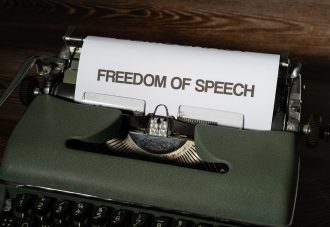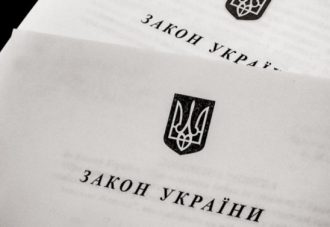The year 2022. Ukraine is fighting with the last European empire – the so-called “Russian” and the so-called “Federation”. This is a battle on the ground with an enormous number of civic victims and destroyed villages, towns, and cities, where the best Ukrainian people die every day. But this battle is not about land, the Russian language, or the so-called Russian zone of interest, it is not even about natural resources. The full-scale war in Ukraine, which Russia started on February 24, 2022, is the method used by an autocratic regime to fight with a neighbor that has a democracy, freedom of speech, freedom of assembly, and, frankly speaking, freedom in its DNA. Such neighboring is dangerous for Russia because it exhibits an alternative way of development as well as the fact that power is not something citizens should be scared of. Moreover, it shows that corruption can be fought, and last but not least, presidents must be changed after the second term to avoid making the whole country a pocket toy for a ‘privileged’ group of people.
Unlike a lot of other Soviet republics, Ukrainians have already elected the 6th president (Russia and Belarus have de-facto had a mere 2), and Ukraine developed democracy even though the most important reforms such as the court system and anticorruption reform are still ongoing.
Russia has made numerous attempts to take back control over Ukraine since the Crimean Crisis of 1992-1994 through the support of Kuchma, pressure over gas prices, etc. The economic crisis of 1998 focused Russia for some time on its own problems, but in 2004 the Orange Revolution as a social response to Russian-backed autocracy happened. The 2013 Revolution of Dignity happened for a similar reason – pro-Russian, or rather a Russian puppet president Yanukovych, corruption, pressure on independent media and entrepreneurs, and the attempt to change the political course from a European perspective to Russian-controlled quasi-unions.
When Russia failed to establish a puppet regime in Ukraine, its government decided to punish Ukraine for freedomness and occupied Crimea in March 2014 and parts of the Luhansk and Donetsk Regions. It started an 8-year hybrid war, which finally turned into a full-scale war on February 24, 2022.
The war caused the biggest humanitarian crisis since WWII – millions of refugees and internally displaced persons, damage to the economy and ecology totaling billions USD. At the same time, Ukraine did not fall, businesses relocate or close down, while new ones appear. Some people are so brave that they continue working in the cities which are under everyday Russian missiles attacks.
Under these circumstances, Ukraine continues its European vector and finally on June 6, 2022, got a status of a European Union candidate country. The status must be submitted, and Ukraine must pass 7 reforms, one of them is the media reform. And on December 31, 2022, the Law on Media was published. But, the story of the media reform began many years ago.
The story
Media legislation in Ukraine was created mostly in the early 1990s. It was a time of newspapers, TV channels, state ones, and a small number of private media such as print media and cable TV with unstable programming and not always (or rather never) legal content. It is difficult to imagine another way of developing the Ukrainian media field due to the Soviet ’heritage’, broken traditions of fair business, due to 70 years under Soviet occupation, hyperinflation, and the struggle of economics, etc. And with the huge influence of ‘Russia’ which was not ready to give freedom to the countries colonized for the last centuries.
All these factors caused an ‘oligarchization’ of the media market. The main TV channels appeared or became concentrated as a media asset of the business empires owned by a small number of oligarchs on local levels, such media are also controlled by local ‘business elites’ or politicians (in some situations by the same persons). At the same time, these factors caused numerous failures in the creation of independent public service media. Ukrainian public service media UA: PBC appeared only after the third revolution — the Revolution of Dignity, and not in 2014, but in 2017.
During the Soviet times, Ukraine had no independent media. Because the Soviet regime needed strong propaganda for its population, freedom of speech, assembly, and even private property was not possible at that time. Only during the last years of the USSR’s collapse, in the times called ‘Perestroika’ (rebuilding), private print media appeared.
But audiovisual media in the USSR were not even a state organization, as was the case in Poland of the time of PRL or other central and eastern European countries. Radio and TV in the Ukrainian SSR were incorporated into the state executive body – the State Committee on TV and Radio, which designed broadcasting mostly as part of an official Soviet info/propaganda machine with cultural domination of the Russian nation, Russian language, and culture.
The first Ukrainian law on print media appeared in 1992, and the law on TV and radio broadcasting appeared in 1993 (as amended in 2006). In 1997, a package of 4 media laws was adopted, but the law on public service broadcasting, as one of them, became a ‘dead law’ half a year after its adoption. The Law on covering activities of the state bodies and local authorities became the most non-democratic law in the media legislation and will be finally revoked only in 2023. From time to time, some huge scandals based on attempts to put pressure on the media appeared. In some cases, media were destroyed by false defamation cases, as was the case with the popular newspaper “Silski Visti” in the late 1990s. In other cases, judgments of the European Court of Human Rights help to resolve issues that require final resolution. For example, in the case “Ukrainian Press-Group vs. Ukraine” 2004, the Court made a devastating decision which says that value judgment is not subject to proof. Another case – “Editorial office “Pravoye Delo” & Shtekel vs. Ukraine”, 2015, shows a huge gap in the regulation of news websites or online media under the future law.
Such cases even caused quite unique amendments to the legislation, for example the progressive scale of court fees, which was aimed at the decrease in the number of false insult cases in Ukrainian courts in 2003-2011. At the same time, no regulation for the online news papers and magazines and online broadcasting is present until the new law is enacted in April 2023. On one hand, it helps Ukraine to go through its darkest pages of authoritarianism, on the other hand, it gives unlimited and uncontrolled space for Russian propaganda and lies, which affect democracy, cause artificial conflict zones, and decelerate the country’s development. Also, it is not fair from the economic point of view: one player has a lot of obligations, while the other one has a mostly unlimited field to operate.
From time to time, the journalistic community made attempts to create a print media council and even adopted Code of Journalistic Ethics in 2003 and created a Commission on Journalistic Ethics. However, these attempts failed, and no print media council is present in Ukraine. The most effective journalistic initiatives were aimed against authoritarian attempts to censor informational space in direct or indirect ways. One of the most famous was ‘Stop Censorship!’ movement, which was active in2010-2015. Unfortunately, because of economic reasons and fear of losing jobs, journalists were not ready to fight for their rights and independence.
Why now?
There are three main reasons why Ukraine needs new media legislation now. Firstly, Russian aggression showed that Ukrainian media legislation was not ready for such circumstances. Neither regulator nor provisions of the laws have enough instruments to contradict the disinformation, propaganda, and cynical lie of the so-called Russian media, both official and even opposition ones, which cynically referred to the occupants as “our boys”. And this problem is quite natural – Ukraine has never planned to start a war, unlike Russia. Secondly, current Ukrainian laws written in a paradigm of “traditional” technologies do not match the current challenges of convergent media, social networks and so on. Of course, even media law will not respond to the threat of the messenger ‘Telegram’ (which has questionable security policies and is widely used in Ukraine) – it’s the next step for Ukrainian legislation development. The third one is the European vector, which means that rules applied in Ukraine must be more or less similar to the rules of the European directive.
The development of media legislation in Ukraine is always closely connected with the political environment, political agenda, and also with the technological growth of the IT/telecom sphere.
From the political point of view, for many years freedom of speech was grounded on the so-called oligarchic pluralism, where the presence of different channels with different political focus created a field in which consumers could compare the content of different channels, their agenda, messages (at least theoretically) and create a more or less balanced picture of current events. In practice, people mostly watch 1-2 channels, which represent views of one or another political party. As a result, consumers ignore other channels.
From the technological point of view, Ukraine made several breakthroughs in IT and TV areas, passing stages our western partners went through evolutionary. As for the internet, we jumped from low-quality dial-up 30 Kbps internet to 100 Mbps (now – 1Gbps home internet), from EDGE GSM internet to mostly 3G/4G. Internetization became quicker and cheaper, which allowed for a quick growth of networks and covered the population with at least one type of internet access. As for terrestrial broadcasting, because of corruption and authoritarianism, Ukraine selected the newest standard at that time, DVB-T2, with MPEG-4 codec, passing both DVB-T and MPEG-2, which allowed it to put more channels in multiplexes. Several national TV channels (28 in total) cease operations before the full-scale invasion.. In some regions, several local channels also do not meet the capacity of the advertisement market — the main source of media income.
But in the last decade, the traditional media lost its position. Online (paperless) media, YouTube, social media, and Telegram messenger were taking more and more pieces of the pie of the audience’s attention. And at the same time, we have a lot of rules for ‘traditional’ media and not so many for the new ones, which negatively affects actors who must have more or less equal rights and obligations (of course, with some specifics as tothe type of distribution, wage, etc.).
Also, it’s about Ukraine and its ability to fulfill its obligations. The obligation to bring the media legislation in line with AVMS Directive (2010) was mentioned in the Ukraine-European trade agreement. Unfortunately, we failed this story – the draft law was ready in 2019, but due to elections and lack of political will this act had no chance to be passed. Moreover, the amendment of the Directive in 2018 caused a problem for the legislator. They did not know which edition to pass:the2010 or 2018edition. However, this problem disappeared in 2022, when the European Commission recommended granting Ukraine the status of the EU candidate country if we finally pass a media law and implement another 6 reforms. In such conditions, Ukraine had no other choice – just to finalize and fulfill this obligation.
On December 13, 2022, the Ukrainian parliament finally adopted a 277 pages long law and on December 29, 2022, the President of Ukraine signed it. The law will come into force on March 31, 2023.
Why law on media?
Primarily, this law was developed as a new edition of the law on TV and radio. It was a time of the domination of the ‘classic’ TV and radio. But we went through the Revolution of Dignity, which created a huge 3-year window of opportunity in the legislation area: Ukraine pushed rapidly its digital transformation both in telecom services and state services, Diia and State in Smartphones projects became a reality in a short period of time. Social media snowballed, especially after the full blocking of the Russian ones: Vkontakte and Odnoklassniki. As a result, a lot of media developed its digital divisions, some media became paperless, and some appeared as new ones. Recent studies show that users, in particular in the time of Covid-19 pandemic, equalized the consumption of the so-called ‘traditional’ and ‘new media’. In such conditions, it’s not fair to develop rules only for one technology of content distribution and not have rules for another, while both fighting for the attention of the similar audience and for the same pie of ad market.
But such a tendency in Ukraine was not observed only in COVID time: Revolution of Dignity was a digital revolution – Ukrainians and the whole world were able to watch online the events that happened on Maidan during the Revolution of Dignity via bloggers and a few independent media streams.
That’s why in 2019 the new parliamentary Committee on Humanitarian and Informational Policies decided to extend the draft law to the whole media sphere: print, TV, radio, digital and additional services. In the time of the non-proclaimed war, in the time when media have been used for decades as an instrument in economic or political wars with the absence of self-regulation, the state must be more strict with a sphere that has a direct influence on democracy per se. Of course, it’s not about censorship, it is rather about fair rules, transparency of the players, responsibility for disinformation, and so on.
Also, one of the more philosophical and theoretical ideas behind the law is to change the terminology. In countries that escaped from the Soviet ghetto, the media was referred to as an ‘instrumentality/means of mass information”. This term diminishes the role of media to the role of an object or service, not the important player and fourth estate. Moreover, for a long period of time in election laws, legislators used a construction “using means of mass information in a process of elections’, giving the media an absolutely passive role in this vital country process. And finally, means of mass information are used both for legal entities and products they develop like newspaper X or TV channel Y. This caused a mess in regulation. Thus, for the legal entity ‘media’ as a new term and ‘provider of media service’ – is about cultural changes and respect.
What/who will the law cover?
Primarily the law is based on the AVMS directive and its definitions, but due to numerous reasons mentioned above, our law also covers not only linear (TV and radio), and non-linear (VoD), but also other services and providers. Let’s have a closer look at them.
Providers of audiovisual linear services:
- Radio broadcasting;
- Television broadcasting.
Providers of non-linear audiovisual services:
- On-demand audio media service;
- On-demand audiovisual media service.
Providers of the special types of audiovisual media services:
- UA: PBC – Ukrainian public service media – it can provide both linear, non-linear services and has online media.
- FREEDOM and UA|TV – audiovisual media services of foreign broadcasting;
- Local public audiovisual media services and audiovisual media services of communities;
- Channel of parliamentary broadcasting Rada.
Providers of the non-audiovisual services:
- Print media;
- Online (paperless print) media.
Providers of services, which are not media, but have a huge influence on the packageof the audiovisual services:
- Audiovisual service providers (ASP);
- DVB-T2 providers or provider of electronic communications services for broadcasting needs with the use of radio frequency resource.
*red color marked services that are not under AVMSD
Separate entities are Video Sharing Platform Providers, which is a result of the 2018 edition of the AVMS Directive.
The Law establishes a number of requirements for entities that want to become service providers. It’s about ownership, and relations with the aggressor country (– i.e. Russia and possibly Belarus, Iran, or other countries, which may be recognized as such).
The main requirements and restrictions for entities:
|
|
linear |
nonlinear |
print media |
online |
ASP |
DVB-T2 |
VSP |
|
Must be a legal entity or individual entrepreneur |
Y (terrestrial) |
Y (terrestrial) |
n/a |
n/a |
Y |
Y |
n/a |
|
Ultimate beneficial owner or key shareholder in a media entity must be citizen of Ukraine or Ukrainian state authority |
n/a |
n/a |
n/a |
n/a |
n/a |
Y |
n/a |
|
No key shareholders in the media ownership structure in offshore zone available |
Y |
Y |
Y |
Y |
Y |
Y |
Y |
|
Annual financial audit |
only nationwide TV |
n/a |
n/a |
n/a |
n/a |
n/a |
n/a |
|
Cannot be founded by state authorities, local authorities, political parties (except for scientific, educational and cultural entities and special media subjects under this law) |
Y |
Y |
Y |
Y |
n/a |
n/a |
n/a |
|
Cannot be founded on all levels of the media ownership by religious organizations, international organizations, state bodies of the foreign countries |
Y (terrestrial) |
Y (terrestrial) |
n/a |
n/a |
n/a |
n/a |
n/a |
|
Additional requirements under the martial law |
|||||||
|
Prohibition for the natural persons and legal entities of the aggressor country (registered or located there) to be media entities |
Y |
Y |
Y |
Y |
Y |
Y |
Y |
|
Prohibition for the ultimate beneficial owner or key shareholder from the aggressor country |
Y |
Y |
Y |
Y |
Y |
Y |
Y |
|
Prohibition for the legal entities which are financed by the natural persons or legal entities of the aggressor country |
Y |
Y |
Y |
Y |
Y |
Y |
Y |
Y – requirement is applied, n/a – not applicable
Licensing and registration
The current legislation has provisions that require a license for all types of audiovisual linear services, ASP, and the registration procedure of print media are quite similar to the licensing. Other types of media players are not mentioned in the current legislation.
The law on media changed this concept. Only terrestrial services would require licenses: radio, TV broadcasting, and services of DVB-T2 provider. Licenses are granted under the contest procedure, except for the minimum guarantee for the public service media. A license would be granted for 10 years.
Registration is obligatory for audiovisual media that do not use radio spectrum, ASP, and VSP. Such requirements applied to entities registered in Ukraine or to entities that fit with the requirements in article 2 of the Law, which defines jurisdiction criteria (percentage of staff, content distribution, editorial decisions, etc.). Print media and online media can be registered on voluntary basis. For the print media, a requirement is envisaged: from the moment of parliamentary decision which defines certain country (currently – Russia) as an aggressor country till 5 years after the cancellation of such decision, print media must be registered on an obligatory basis. If an entity provides accurate and all required information, the regulator will register it not later than 1 month after an appeal.
The law also has one specific procedure: 1-year temporary broadcasting permits. Primarily, this regime was invented as a response to the destruction of telecom towers and jamming by the Russians in 2014-2015. The law says that such a regime can be used only in the territories which have a status of territories with a special broadcasting mode (as defined by the National Council) on a non-competitive basis if no martial law or state of emergency is imposed.
One important new feature of the law is the system of the personal account. Personal account aimed to create a paperless system for all procedures: registration, licensing, notifications, self-updates in cases where the registrant/licensee must update information about media ownership structure, and so on. Also, the personal account will be a source of information for public registers, which the regulator will be obliged to publish on their web portal.
Voluntarily vs. obligatory
Print media and online media in normal life will have no obligation to register as media. But, what is important, the National Council will have jurisdiction even if the media wasn’t registered. Article 116 of the Law says that both registered and non-registered media could be punished by the National council with a fine or double fine. But in the case of registered media, the maximum sanction is a cancellation of registration, in the case of non-registered ones – prohibition of publication and distribution of the print media based on the court judgment. Moreover, registration could be useful for the journalists of such media both for accreditation and protection under criminal legislation.
One of the most popular questions on manipulation is whether YouTube bloggers must be registered under the law. The answer is no, however they can do so. Article 16 says that users of the information-sharing platforms, in case they produce and share content under their editorial control, could be registered as an online media outlet.
Obligations and content limitations
There are a number of obligations for all types of media. Some of them are common for all types of services, some are technology-specific.
As for common obligations, these include providing the regulator with information on actual media ownership structure as well as publishing it on their website. Also if some service is provided for a fee, they have to notify users about such fee and possible ways of payment.
As for common limitations, these include prohibition of the propaganda of war and terrorism, hate speech, discrimination on the grounds of race, religion, gender, and other types of discrimination; pornography, propaganda of drugs and psychotropic substances; propaganda of animal cruelty. Also, there is a prohibition on the distribution and demonstration of films, in accordance with the Law of Ukraine “On Cinematography”, materials or information that deny or justify the criminal nature of the communist totalitarian regime of 1917–1991 in Ukraine, the criminal nature of the National Socialist (Nazi) totalitarian regime, Russian Nazi totalitarian regime, armed aggression of the Russian Federation as a terrorist state against Ukraine, as well as symbols of such regimes, and statements which deny Ukrainian language, nation, and state.
For the linear, nonlinear, print, and online services, there are additional requirements for providing output data.
Linear media must adopt and publish editorial charter on their websites. For content distribution, there is a requirement to allocate not less than 50% of the weekly broadcasting time for the national product, except for media for kids, where only 25% is required, and for specific genres of media there is no such requirement. As for European products, nationwide and regional media must meet 50%+ requirements, other than in situations where their rates and market shares are so small that the regulator could establish another quota. Nonlinear media must allocate not less than 30% of their catalog to European programs, and such content must be visible. Also, there is a requirement originated from AVMSD – not less than 10% of the content of the nationwide and regional linear media must contain products developed by independent studios.
One of the specific requirements for broadcasters is a language requirement. Such provisions are difficult to explain to the people from other countries, but for Ukraine citizens, the language topic is quite sensitive. This problem was enrooted in the 19th century when the Russian empire prohibited the Ukrainian language in Valuev and Ems Decrees. Soviet power continues this ‘tradition’ using both cultural and even vocabulary repression, as well as using a policy of resettlement to change the ethnic composition and, as a result, language usage in some regions. Nowadays, the same policy is being introduced in the occupied Crimea and other territories occupied by the Russian occupation army. Another way of influence – Russia used economic pressure via price dumping to fill the content market (books, print media, video, etc.) to spread content in the Russian language, which is understandable due to the Soviet occupation that affected the majority of the population. That’s why Ukraine had no choice but to establish protectionism-focused instruments in legislation.
the media law contains provisions of different laws developed for old media legislation. As a result, there is a requirement for the linear nationwide and regional terrestrial broadcasters to have a 90% weekly quota of the content in Ukrainian in the following time slots: 7 am – 6 pm and 6 pm – 10 pm. For the local broadcasters, the quota is 80%. The same quotas exist for non-terrestrial broadcasting. Radio broadcasters must meet a 40% daily quota of the total number of broadcasted songs in the Ukrainian language from 7 am to 2 pm and from 3 pm to 10 pm. Such a quota could be decreased to 25% if the total number of songs originating from the EU is 60% both daily and in the above time slots. The Law also establishes additional requirements for news programs.
As for other requirements, the Law contains AVMSD requirements for children’s protection, right to reply, access to information on events of significant public interest etc.
Additional obligations and limitations in a time of war are prescribed by the IX chapter of the law. In general, these requirements are based on counter-Russian propaganda about the civil war in Ukraine, propaganda of the officials of the aggressor state, as well as content with persons who supported aggression against Ukraine or persons who threaten the state.
Sanctions
The Law changed the paradigm of sanctions. Under the current system of sanctions, a service provider must be punished even if a violation is minor. But the new Law establishes a new instrument – Instruction. If a violation happens for the first time and it is minor, the Regulator can notify the licensee or registrant about the fact of the violation but should not impose fines. Only if violations are repeated (5 times during one year), will the National Council fine a media entity. If a licensee or registrar commits the violation repeatedly, a double fine will be imposed.
The highest level of sanctioning is a court trial initiated by the regulator after 6 major or second gross violations. The court could revoke a license or cancel the registration.
For online media, the National Council also uses the instruction-fines-double fines system. In the case of registered media, the highest penalty is canceling registration. In the case of non-registered media, it is blocking for 14 days (for major violations). If such media have fines for gross violations, such media could be temporarily blocked by the court decision.
National council and co-regulation
One of the most important changes brought about by the new Law is the increasing role of the media Regulator: The National Council on TV and Radio Broadcasting (the name of the body can’t be changed due to the fact that this name was fixed in the Constitution, which can’t be changed under the Martial Law).
The Law establishes new guarantees of independence and transparency for the members of the National Council as well as improved mechanisms for the election of the members of the National Council. In the current law, there is no procedure for the appointment of the 4 members by the President of Ukraine (the Constitution says that half of the members of the National Council are appointed by parliament, half – by the President of Ukraine. Since 1993, the number of members has been8 — 4:4). Under the new Law, the new contest commission must be established by the presidential decree. Such a commission prepares a shortlist for the President, and they appoint members from this shortlist.
Also, there is an important provision about salaries. The Law establishes the amount of salaries for the members, which is one of the elements of their independence and prevents bribes. As for the whole institution, the law for the first time has fixed the minimum level of financing of the National Council per se. The Law uses a similar formula used for the financing of public service media: the National Council must be financed at the level of 0.0022% of the general expenses of the state budget of the previous year. At the same time, the Law allows other sources of income – 4% of the rent for using radio spectrum, international technical aid, etc.
The National Council must also change the way it works. During the first year, a three-year Strategy must be developed and adopted. This document must define the main activities and goals of the Regulator and must be revised (replaced if needed) every 3 years. Based on the Strategy, the National Council must adopt an annual Implementation Plan every year, which states future contests and priorities.
Co-regulation is an experimental and quite unique instrument for the media sphere and Ukraine as well. Authors of the law tried to involve the market in policy development as a first step on the long way to self-regulation. Co-regulation aimed to develop codes of conduct and other regulations at the operational level which could quickly respond to the cases and challenges that appeared in the media sphere and where the common agreement between the media entities could be the most effective response to such challenges. For example, it’s about criteria in which online resources must be defined as online media, a system of notification about age and type of content (similar to Kijkwijzer). Under Law, 5 co-regulation bodies could be created in the spheres of the linear, non-linear, print media, online media, and VSPs. Co-regulation means that the Regulator is involved in the process of developing the codes and submitting the final edition, however, the market players are responsible for their development and signing, which means voluntary fulfillment of commitments.
Another important function of the co-regulation bodies is passing an opinion on the specific cases that happened with media in the area of content distribution. Expert commission of the co-regulation body could provide arguments that a violation of the code of conduct or other rules had happened or vice versa no violation is found. This mechanism could be used only by the members of such a body, as well as serve as a soft stimulation to become a member of such a union.
What’s next?
The Law aims to start one of the most ambitious and important reforms in the Ukrainian media sphere – a media reform per se. And this reform started at times when the whole world faced Russian fascism and neoimperialism, which threatened the international order and democratic values and even created a food crisis. But reforming the media sphere is not about merely changing the rules of the game, bureaucracy, or sanctions. It’s about democracy per se. Democracy could not exist without the freedom of speech, and freedom of speech could not be guaranteed without responsive journalism and independent media, and without an independent Regulator. The new Media Law has one of the most ambitious goals – to change the culture of the media market and to build a foundation for trust.
Starting in early 2023, a lot of documents must be developed to properly start the law on March 31. Total review of all regulatory acts of the National Council, cancellation or review of some acts of the Cabinet of Ministers, Ministry of Culture and Informational Policy, and Ministry of Justice should be ensured. Also, these actions should start the process of the proper budget funding for 2024. And of course, a lot of explanations and training must take place in the next 3 years.
The creation of co-regulatory bodies is a good test for the media market so that it could become an active part of the policy process and be responsible for the fulfillment of commitments.
The story of the Law is only beginning.





